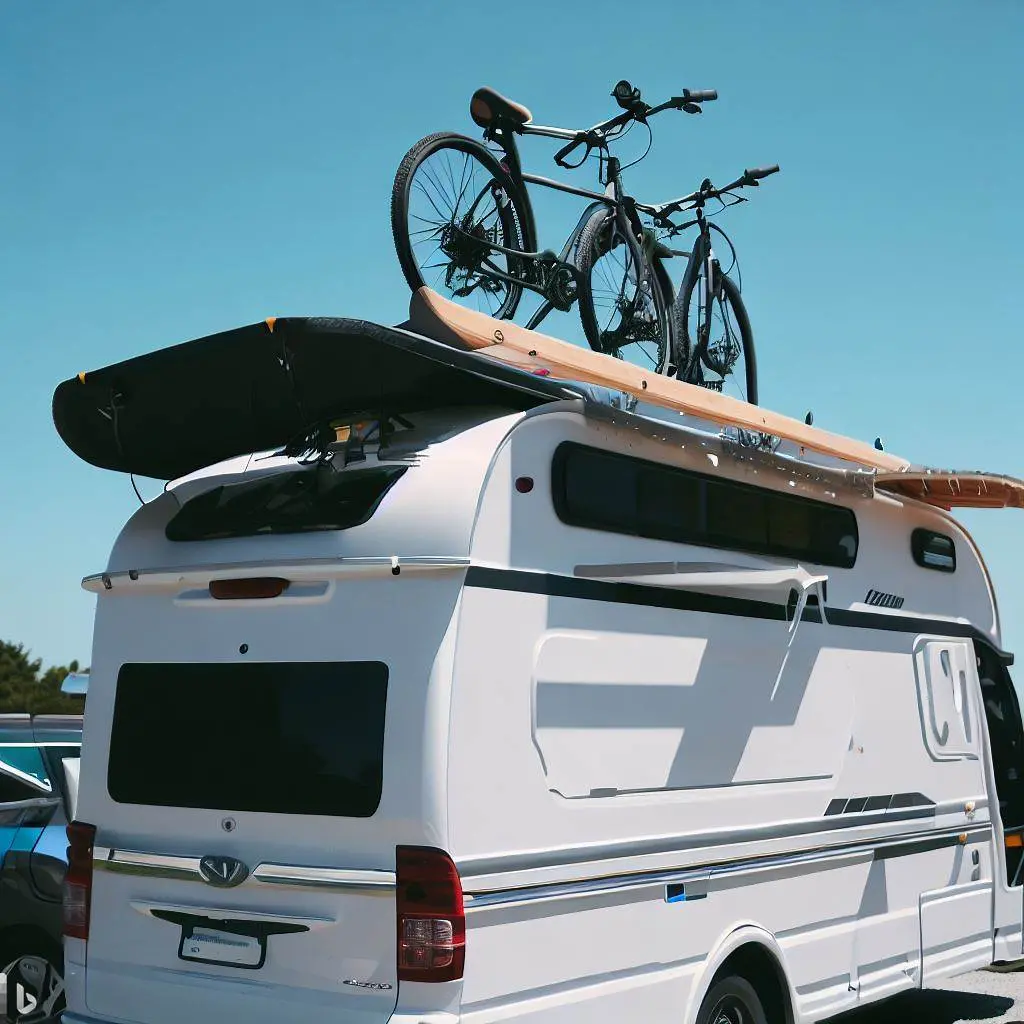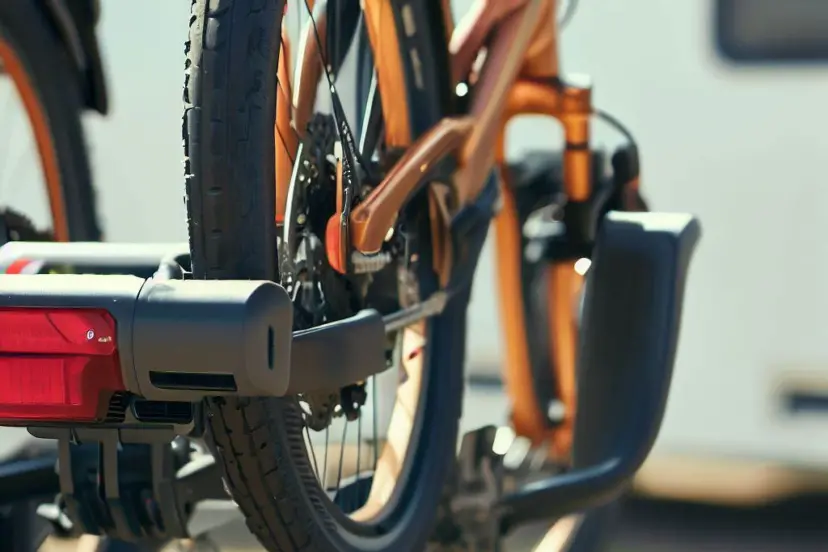Unlock the Secrets of RV Bike Racks: Your Ultimate Guide to Convenience and Security on the Road
What you should consider when picking a bike rack for an RV: Convenience, Security, and Adventure
Bringing our bikes along on our adventures enhances the thrill of exploring new trails and enjoying the great outdoors. Whether you are exploring RV parks in Monterey CA, Lake of the Ozarks RV parks, or camping in Baytown TX taking your bikes to help explore the area will enhance your trip.
But with so many bike rack options available, finding the perfect one for our RVs can be overwhelming. In this comprehensive guide, we’ll explore the world of RV bike racks, uncovering convenience features, security measures, and the best options to carry bikes on your motorhomes or campers. From hitch-mounted racks to roof-mounted models, we’ll cover it all, helping you decide on your biking escapades.
Choosing the Right RV Bike Rack for Your Adventure Rig
As someone who’s passionate about both RV camping and hitting the trails on my trusty bikes, I know how crucial it is to find the perfect RV bike rack that suits your needs. Let me share some helpful suggestions on choosing the right RV bike rack based on your RV’s bumper capacity. Keeping your bikes secure and ensuring a smooth journey on the road is essential, so let’s dive in!
Understanding Your RV’s Bumper Capacity
Before exploring different bike rack options, you must know your RV’s bumper capacity. This capacity determines the weight limit your RV’s bumper can handle, and it’s crucial to select a bike rack that stays within this limit. You can find this information in your RV’s owner’s manual or by contacting the manufacturer. Overloading the bumper can lead to damage and jeopardize your bikes’ safety, so always stay well-informed about this aspect.
Consider Hitch-Mounted Bike Racks
Hitch-mounted bike racks are popular for RV owners due to their versatility and ease of use. They attach to the hitch receiver at the back of your RV and come in various configurations, such as platform-style and hanging racks. Platform-style racks provide excellent support for bikes and are suitable for heavier e-bikes or mountain bikes. Hanging racks, on the other hand, are lighter and more affordable but may require extra support for some bike frames.
Assess Your Bike Carrying Needs
Think about how many bikes you typically carry on your RV trips. Are you traveling solo, with a partner, or with a group of friends or with your kids? This consideration will help you determine the size and capacity of the bike rack you need. Some RV bike racks accommodate up to four bikes, while others only carry one or two. Additionally, if you have different types of bikes, like fat-tire bikes or children’s bikes, ensure the rack can support them.
Prioritize Stability and Security
While on the road, your bikes are subject to bumps, vibrations, and sudden movements. Therefore, choosing an RV bike rack that offers excellent stability and security is crucial. Look for features like anti-sway technology and secure tie-downs to prevent bikes from banging into each other or your travel trailers during travel. Locking mechanisms are also essential to deter theft and keep your bikes safe while away from the RV.
Weight and Materials Matter
RVs have weight limits, and every extra pound counts. Opt for a bike rack made from lightweight materials like aluminum or high-strength steel. Not only will this help you stay within your RV’s weight capacity, but it will also make the installation and handling of the rack much easier. Remember, you’ll be loading and unloading bikes regularly, so a lightweight yet sturdy rack is a winner.
Consider the Rear Access
Before settling on a bike rack, think about how it will affect the accessibility to the rear of your RV. Some hitch-mounted bike racks can tilt or swing away, allowing you to access the storage compartments without removing the bikes. This feature can be a game-changer when you need to grab some camping gear without unloading all your bikes.
Seek User Reviews and Recommendations
Finally, always do your research! Read user reviews and seek recommendations from fellow RVers who have experience with the bike racks you’re considering. Learning from the firsthand experiences of others can provide invaluable insights and help you make an informed decision that suits your specific RV camping needs.
Exploring the Best RV Bike Racks for Fat-Tire Bikes
 Let’s dive into the world of RV bike racks and explore options that can accommodate fat-tire bikes for an amazing biking experience on your RV trips!
Let’s dive into the world of RV bike racks and explore options that can accommodate fat-tire bikes for an amazing biking experience on your RV trips!
The Challenge of Fat-Tire Bikes
Fat-tire bikes are gaining popularity among outdoor enthusiasts due to their ability to conquer diverse landscapes, including sand, snow, and rocky trails. However, their unique wide tires present a challenge when it comes to fitting them onto standard bike racks. The extra width can cause interference, making it difficult to secure the bike properly and potentially damaging the tires or frame during transport.
Hitch-Mounted Racks for Fat-Tire Bikes
If you’re looking to carry your fat-tire bike on your RV, hitch-mounted bike racks are a great option to consider. These racks come in various designs; some are specifically designed to accommodate fat-tire bikes. Look for racks that feature adjustable wheel holders to accommodate different tire sizes. Some models also offer extended spacing between bikes, allowing for more room to accommodate wider tires without the risk of rubbing or scratching.
Platform-Style Racks for Added Stability
Opt for a platform-style hitch-mounted bike rack for the utmost stability and security when carrying fat-tire bikes. These racks provide a sturdy platform for your bikes to rest on, eliminating any travel trailer swaying or contact between bikes during travel. Many platform-style racks also feature integrated wheel straps or ratcheting arms that firmly secure the tires, preventing any wobbling or movement while on the road.
Consider a Vertical Bike Rack
A vertical bike rack is another innovative option for carrying fat-tire bikes on your RV. These racks allow you to mount the bike vertically against the rear of your RV. Positioning the bike vertically saves space and reduces the risk of tires interfering with each other. Some vertical racks have adjustable clamps to accommodate fat-tire bikes, providing a secure and space-efficient solution for your adventurous rides.
Carrying fat-tire bikes on your RV doesn’t have to be a challenge! With the right RV approved bike rack, you can confidently hit the road with your travel trailer, knowing your beloved fat-tire bikes are safe and secure. Remember to look for hitch-mounted racks with adjustable features and consider platform-style or vertical designs for added stability and convenience.
Is a Roof-Mounted Bike Rack the Right Choice for Your RV? Let’s Weigh the Pros and Cons!
Let’s take a closer look at the advantages and disadvantages of using a roof-mounted bike rack on your RV, so you can make an informed decision for your biking escapades!
Advantages of Roof-Mounted Bike Racks
- Preserves Rear Accessibility: One of the significant benefits of a roof-mounted bike rack is that it leaves the rear of your RV accessible. You can easily open the rear doors or access storage compartments without the need to remove the bikes, making it convenient when you need to grab camping gear on the go.
- Accommodates Various Bike Styles: Roof-mounted racks can carry a wide range of bike types, including road bikes, mountain bikes, and even fat-tire bikes. This versatility makes them an excellent choice for those with multiple bike styles in their arsenal.
Disadvantages of Roof-Mounted Bike Racks
- Challenging Bike Loading and Unloading: The most significant drawback of roof-mounted racks is the challenge of loading and unloading bikes onto the roof. Lifting heavy bikes overhead can be physically demanding, especially after a long day of biking.
- Reduced Clearance: With bikes mounted on the roof, the overall height of your RV increases. This can limit your clearance when driving under bridges or through low-clearance areas, requiring extra caution on the road.
- Impact on RV Stability: Having bikes on the roof can affect the center of gravity of your RV, potentially leading to decreased stability and increased swaying, especially during windy conditions.
Assess your requirements, consider these factors, and make a confident choice for your next RV biking adventure!

Towing Your Adventure: Exploring the Use of Towed Vehicle Bike Racks for Your RV
Understanding Towed Vehicle Bike Racks
Tow vehicle bike racks, are designed to carry bikes on a vehicle being towed behind your RV. These racks are different from traditional bike racks that attach directly to your RV’s hitch or roof. Towed vehicle bike racks offer a solution for RVers who tow a car or a smaller vehicle behind their motorhome.
The Pros of Towed Vehicle Bike Racks
- Versatility: Towed vehicle bike racks can carry a variety of bike types, including road bikes, mountain bikes, and even electric bikes. This versatility allows you to bring along your favorite bikes wherever your RV adventures take you.
- No Impact on RV Maneuverability: Since the bikes are carried on the towed vehicle, they do not affect the maneuverability or stability of your RV. You can drive with ease, knowing that the bikes won’t sway or impact your RV’s balance.
The Cons of Towed Vehicle Bike Racks
- Added Weight and Towing Capacity: Adding bikes to the towed vehicle will increase its weight, potentially affecting its towing capacity. It’s crucial to ensure that the combined weight of the bikes and the towed vehicle remains within the manufacturer’s recommended limits.
- Limited Accessibility: While the bikes are safely stored on the towed vehicle, accessing them might require additional effort, especially if you need to stop to access the bikes during your journey.
Using a towed vehicle bike rack can be a practical solution for carrying bikes behind your RV, especially if you tow a vehicle during your travels. It provides versatility and doesn’t impact your RV’s handling. However, be mindful of the added weight and towing capacity limitations. If you’re considering this option, make sure to check your RV’s towing capacity and choose a reliable and sturdy towed vehicle bike rack that can securely transport your bikes throughout your journey.
Unveiling the Convenience: RV Bike Racks with Rear Storage Access
Say goodbye to constant unloading, and let’s dive into this section to unveil the convenience of RV bike racks with rear storage access!
The Quest for Rear Storage Accessibility
As RVers, we know how valuable every inch of storage space is. Traditional bike racks can sometimes block access to the rear compartments, making retrieving camping gear, tools, or other essentials inconvenient. That’s where bike racks with rear storage access come to the rescue!
The Ingenious Design of RV Bike Racks with Rear Storage Access
These RV Approved bike racks are ingeniously designed to tilt or swing away from the rear of the RV, providing easy access to the storage compartments without the need to remove the bikes. You can pivot the rack away with a simple pull or release mechanism, creating a clear path to your belongings.
Benefits of RV Bike Racks with Rear Storage Access
- Convenience on the Road: The primary advantage of these bike racks is the convenience they offer while on the road. Need to grab some camping gear or set up a quick picnic? No problem! Accessing the rear storage compartments becomes a breeze.
- Space Optimization: By eliminating the need to unload the bikes whenever you need something from the rear storage, these racks optimize space and streamline your RV camping experience.
- Time-Saving: RV adventures are all about making the most of your time. These racks save you valuable time and effort, allowing you to focus on the fun and exploration.
Choosing the Right RV Bike Rack with Rear Storage Access
When selecting a bike rack with rear storage access, consider factors such as the rack’s weight capacity, compatibility with your RV, and the ease of tilting or swinging mechanism. Opt for a sturdy and reliable rack that securely holds your bikes while providing effortless access to the rear storage.
With the convenience of RV bike racks that grant rear storage access, you can embark on your adventures with ease and confidence. Say goodbye to the struggle of unloading bikes every time you need something from the rear compartments.
By investing in the right RV approved bike rack, you’ll enjoy a seamless camping experience, create lasting memories on the road, and have more time for the things that truly matter during your RV journeys!
Securing Your Wheels: Tips to Prevent Bike Theft at the Campsite
Here are some practical tips and tricks to prevent bike theft and ensure the utmost security when using an RV bike rack at a campsite. Let’s lock down our wheels and enjoy worry-free camping!
1. Choose a Quality Bike Lock
Investing in a high-quality bike lock is your first line of defense against theft. Opt for a sturdy and reliable lock that cannot be easily cut or tampered with. Look for locks made from durable materials like hardened steel and consider ones with a secure locking mechanism.
2. Lock Both Bikes and Bike Rack
To ensure maximum security, don’t forget to lock both your bikes and the bike rack to your RV. Use the lock to secure the two bikes to the rack and then lock the rack to the hitch or another secure point on your motorhome.
3. Utilize Secondary Locks
For added protection, consider using secondary locks, such as cable or wheel locks, to further secure your bikes to the travel trailer or hitch rack. These secondary locks can make it even more challenging for thieves to target your bikes and deter potential theft.
4. Park in Well-Lit and Visible Areas
When choosing a campsite, opt for well-lit and visible areas where your RV and bikes can be easily seen. Thieves are less likely to target bikes that are in plain sight and exposed to potential witnesses.
5. Store Bikes Inside Your RV Overnight
Consider bringing both the bikes inside your RV overnight. While bike racks are generally secure, storing your bikes indoors provides protection against theft and harsh weather conditions.
6. Register and Mark Your Bikes
Register adult bikes and the kid’s cycles with the local police or a bike registry service. Additionally, discreetly mark the bikes with your contact information or a unique identifier, making it easier to identify them in case of theft and aiding in their recovery.
7. Stay Vigilant and Be Aware
Finally, always stay vigilant and be aware of your surroundings. If you notice any suspicious activity or unfamiliar individuals near your truck, RV, or bikes, immediately report it to the campsite staff or authorities.
Final Thoughts
By following these helpful tips, we can significantly reduce the risk of bike theft and enjoy peace of mind during our RV camping adventures. Remember, securing our bikes not only protects our valuable belongings but also allows us to focus on the beauty of nature and the joy of exploring new biking trails!
So, let’s lock up and embark on unforgettable RV camping journeys, knowing that our wheels are safe and ready to hit the road when we are!
Exploring with Confidence
With an array of RV bike racks and security measures, you can now embark on your RV camping adventures confidently. Whether you choose a hitch-mounted, roof-mounted to your SUV, or towed vehicle bike rack, or RV approved swinging rack, remember to consider convenience, security, and compatibility with your RV. Safeguard your bikes, explore new trails, and make unforgettable memories as you ride with the wind and immerse yourself in the beauty of nature.
FAQs
- Can I use a bike rack on my RV if I have a rear ladder?
- Yes, there are bike racks designed to accommodate RVs with rear ladders. Look for ladder-mounted bike racks that securely attach to the ladder, allowing you to carry bikes without obstructing ladder access.
- What is the weight limit for bike racks on an RV?
- The weight limit for RV bike racks varies depending on the type and model. Typically, hitch-mounted racks can carry up to 60-100 pounds, while roof-mounted racks may have a lower weight capacity. Always check the manufacturer’s specifications for the specific rack you are considering.
- Can I install a bike rack on an RV with a spare tire on the rear bumper?
- Yes, you can find bike racks that accommodate RVs with rear-mounted spare tires. Look for racks with adjustable arms or offset designs to clear the spare tire and securely carry your bikes.
- Do I need a special bike rack for e-bikes?
- Yes, e-bikes are generally heavier and require sturdier racks. Look for bike racks labeled as e-bike compatible or with higher weight capacities to safely carry your e-bikes.
- Are there bike racks for RVs with slide-out compartments?
- Yes, there are bike racks specifically designed to work with RVs equipped with slide-out compartments. These racks provide enough clearance to avoid interfering with the slide-out mechanism, allowing you to carry bikes with ease.




